Glute Activation
Do you want to improve your performance as a runner, swimmer or endurance athlete? Then let’s talk about our butts. Improved gluteal (butt) muscles can improve athletic power and prevent injury. Read on if you need to be convinced.
First we’ll need to start with some anatomy.
(You can skip this and go straight to the exercises section, but working with hundreds of athletes and clients has taught me that the good ones really do try to understand what’s going on inside their bodies.)
THE ANATOMY
There are 3 parts to the “gluteal complex”:
- The Glute Maximus – That’s our backside buttock muscle. Its main function is to extend the hip i.e. to pull our leg backward.
- The Glute Medius – That’s the one by the side of our buttocks. Its main function is to abduct our leg (move it away from out body).
- The Glute Minimus – That’s underneath our Glute Medius. Its main function is to stabilise our hip as well as to make sure our thigh bone (femur) is in the correct position in the hip socket.
THE FUNCTION
The Glute Maximus is important because it’s a huge source of power in any sport. Running, cycling and swimming kicks all use the Glute Max when performed correctly. Maximize the potential of the Glute max will guarantee improved strokes, strides and kicks.
The Glute Medius and Minimus are vital for stabilising the hips during running. The body is created as an integrated unit, and the Glute Medius and Minimus help to keep everything in line, from ankles to knees to hips and back. Bad alignment in the hips due to poor Glute Medius/Minimus function leads to lower back and knee pain (which many endurance athletes have). Take care of your Glute Medius/Minimus and they will take care of you.
So how do we go about training these muscles so they function well? When a muscle is weak or not functioning optimally, our body has to re-learn the function of the muscle. This is called muscle activation.
Once we have learned how to activate the muscle, we need to integrate it. This puts the newly-functioning muscle into its correct movement pattern together with other muscles and joints to produce smooth, efficient, power-producing and ultimately, race-winning movement.
Think about it: an endurance runner takes about 600 strides per kilometre. That’s 6000 strides over a 10km distance. Imagine if improved glute function due to correct activation and integration increased your stride efficiency by just 4%. That’s the equivalent of 240 strides or about 400m. In fact, 4% is a conservative number. Research has shown that improved strength in the glutes and legs can improve elite middle distance runner timings by 7% or more without spending extra time in training.
Other studies have shown that the difference between advanced amateur cyclists and world-class ones is how the latter use their glutes more than their thighs. Ask yourself: when you ride, do you feel more tired in your thighs or your butt? If your answer is thighs, it’s likely that you aren’t cycling as efficiently as you could be.
THE EXERCISES
Here is the progression for activating your Glute Maximus. Start with the first exercise. When you can feel the contraction in your glutes, and can hold the end position for 10 seconds per leg easily, then move on to the next level.
Hip Extension Over Bench
Instructions: Press your hip bones into the bench. This prevents your hips from moving so that you are able to isolate the glutes. From the start position, bend your leg to 90 degrees with your heel pointed toward the ceiling. From this position, raise your heel toward the ceiling using only your glutes. You should feel only your glutes working. If you feel it in the back of your thigh (hamstrings) or in your lower back, then you are going too high. Lower your leg till you feel only the glutes. As you improve, you will be able to lift your leg higher and higher using only your glutes. Hold the top position with glutes contracted for 5 seconds at first, later working up to 10 seconds per leg. Do 5-10 repetitions per leg.
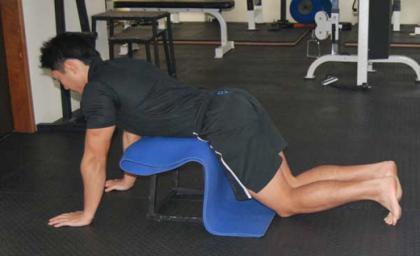
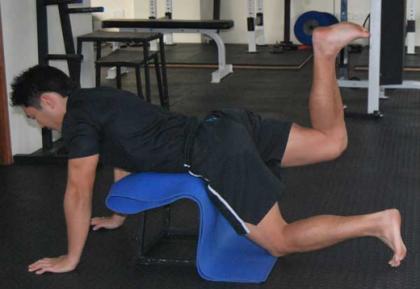
Hip Extension
Instructions: Same as the hip extension over the bench, but this time keep your hips stable without the aid of the bench. Do not let your hips tilt left and right as you raise your heel to the ceiling. You can put a broomstick across your back to check this. If it falls or wobbles a lot, you know your hips are moving too much.
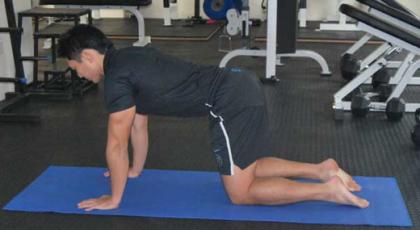
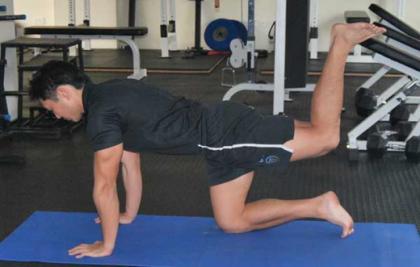
Glute Bridge
Instructions: From a lying flat position, contract your glutes and “pop” your hips upward. Again, use only your glutes and not your hamstrings or lower back. This exercise is harder because your glutes now have to lift your body weight. Hold this position for 5 seconds per rep for 5-10 reps. Working your way up to 10-second holds.
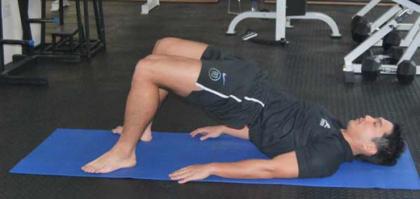
Bird Dog
Instructions: The bird dog combines arm and leg movement in a diagonal across your torso, left arm is lifted as you raise your right leg and vice versa. This simulates the running movement. Again, there should be no activity in your lower back or hamstrings. Use only your glutes. Hold this position for 5 seconds per rep for 5-10 reps. Work your way up to 10 second holds.
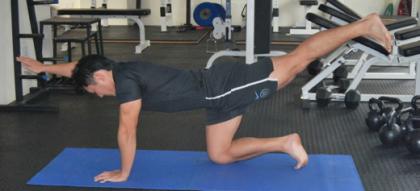
Here are the exercises for activating your Glute Minimus and Medius
Clam Shell
Instructions: Start in the side-lying position with knees bent. From this position, raise your knee using your Glute Medius at the side of your hips. Hold the top position for 5 seconds. Work your way up to 10 sec holds for 10 reps.
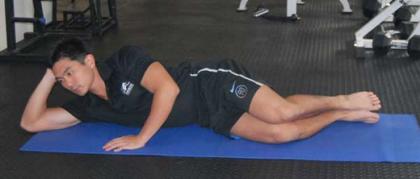
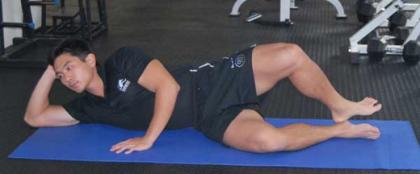
Side Leg Raise
Instructions: For the side-leg raise, the important point is to keep your heel pointed toward the ceiling, this puts the emphasis on your glutes, rather than on other muscles of the hip. Hold the top position for 5 seconds then slowly lower your leg. Work your way up to 10 sec holds for 10 reps.
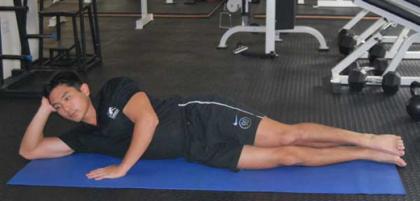
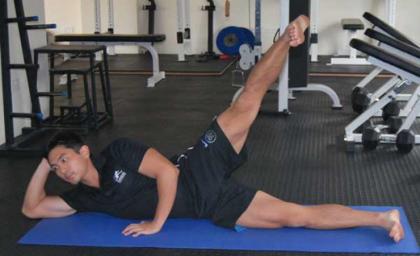
X Band Walk
Instructions: The X-band walk requires a resistance band. Twist it into an X shape as seen in the picture, then you walk sideways like a penguin. Without dragging your feet. Do 10 steps in each direction for 2 sets. A total of 20 steps in each direction. You should feel this movement in the side of your hips.
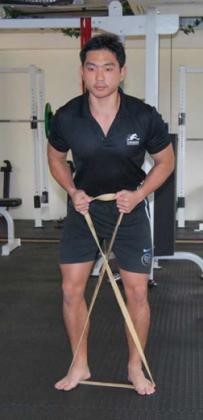
You should add these in during your warm-up before every training session either the run/cycle/swim or during your strength training sessions. Choose one of the Glute Maximus activation exercises and add one of the Glute Medius/Minimus exercises to each warm-up. You are now on your way to better buttock health.
Jonathan Wong is a fitness and sports performance coach, and the owner of Genesis Health & Performance. Jonathan has worked with athletes and fitness enthusiasts of all levels to help them achieve their health, fitness and performance goals. To schedule a consultation or subscribe to his free newsletter and articles, go to http://www.coachjon.com/ Also, check out his daily updates at www.singaporepersonaltrainer.blogspot.com.
References:
- The anatomy and function of the gluteus minimus muscle Martin Beck, John B. Sledge, Emmanuel Gautier, Claudio F. Dora, Reinhold Ganz University of Berne, Switzerland
- Explosive-strength training improves 5-km running time by improving running economy and muscle power Journal of Applied Physiology Vol. 86, Issue 5, 1527-1533, May 1999
Contributed to Coachjon.com, site of Singapore Personal Trainer and Fitness Coach Jonathan Wong
Thank you to Jonathan Wong for allowing me to post this.
Author: Jonathan Wong, Singapore Personal Trainer And Fitness Expert
Originally written for Red Sports.
Click here to visit his site.
